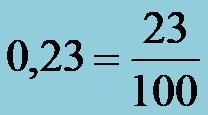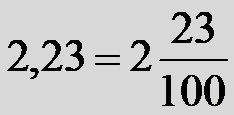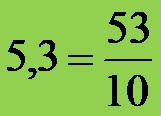In this post, we will devote ourselves to teaching you how to convert a decimal number into a fraction. In the post itself, you have the opportunity to see the conversion of various types of decimal numbers into fractions. Decimal numbers that have or do not have a whole number will be presented here. So if you have any problem with this kind of conversion of record to a numeric value, this is the right place to fix that problem.
We all know that it is extremely important to be able to convert numbers into different types of representations so that we can easily perform all types of mathematical calculations. So let’s pay some attention to this kind of problem!
Converting A Decimal Number To A Fraction
To understand how to convert a decimal into a fraction, we can follow the following rules:
If the decimal number is in the form 0, XY then we place the two decimals in the place of the numerator of the fraction, while the denominator is 100.
Example number 1: Convert a decimal number to a fraction:

The first decimal of the number is 2, and the second is 3. Therefore, when converting to the numerator of the fraction, we will enter 23, and to its denominator 100. The fraction is obtained:

Because the number 23 and the number 100 have no common divisors, the solution is final!
If the decimal number is in the form Z, XY then we place the number Z in the place of the whole part of a mixed number in which the fractional part has a numerator identical to both decimals, and its denominator is the number 100. Finally, we convert the mixed number into an irregular fraction!
Example number 2: Convert a decimal number to a fraction:

The whole part of the decimal number is 2, the first decimal is 2, and the second is 3. Therefore, when converting as a whole part of a mixed number, we enter 2, we enter 23 in the numerator of the fraction, and 100 in its denominator. The mixed number is obtained :

Finally, all that remains is to turn the mixed number into an irregular fraction!

General Rule
If the decimal number has a whole part, then we write that part as the whole part of a mixed number, we write the decimals as the numerator of the fractional part, and the denominator starts with 1 and contains zeros as much as the decimal number has decimal places. Logically, if the decimal number does not have an integer part, then we directly get a fraction, not a mixed number.
Example number 3: Convert a decimal number to a fraction:

Now it is already very easy. We immediately perform the conversion:

See both solved examples (these decimal numbers have different number of decimal places) below:

In the video below, you can see many different examples dedicated to converting a decimal number into a fraction. Be sure to check out these examples to see the above rules applied in specific examples. You can use this video for self-testing in the following way.
- Turn on the video
- Consider some examples
- Decide to test yourself in a concrete example
- As soon as the new example appears, stop the video
- Try to predict the flow of the calculation and the solution of the current example
If you successfully predict the course of the solution and the solution itself, you already know how to successfully convert decimal numbers to a fraction!
If you want to ask any additional questions, you can comment at the end of this post using the contact form at the bottom of the page. Good luck!





